Ask for a reprint
email :
* Give your email
2017
ACL
|
L.Fédèle, F.Sauvage, S.Gottis, C.Davoisne, E.Salager, J.N.Chotard, M.Becuwe, '2D-layered lithium carboxylate based on biphenyl core as negative electrode for organic lithium-ion batteries.', Chem. Mat. 29 546-554 (2017) doi:10.1021/acs.chemmater.6b03524
A 2D-layered conjugated organic lithium carboxylate based on 4,4’-biphenyl core has been synthesized and characterized by combining powder x-ray diffraction, two-dimensional solid-state 13C NMR and high-resolution transmission electron microscopy. The combination of these complementary technics are identifying both molecular packing and structural organization within the solid. The electrochemical performances of this new organic negative electrode have been evaluated. The specific 2D-layered offered by the 4,4’-biphenyl framework confers to the material an unprecedented rate capability, maintaining as high as 180 mAh.g-1 over 25 cycles at 2e- / hour rate without any means of electrode formulation. Such electrochemical performances are ascribed at once to the enhancement of lithium conduction inside the mesoscopic crystal structure, promoted by the greater distance between the inorganic LiO4 layers and to the greater structural robustness upon cycling sustaining no structural amorphization during lithium insertion by contrast to the other members of the series of carboxylate-based organic electrodes.
|

|